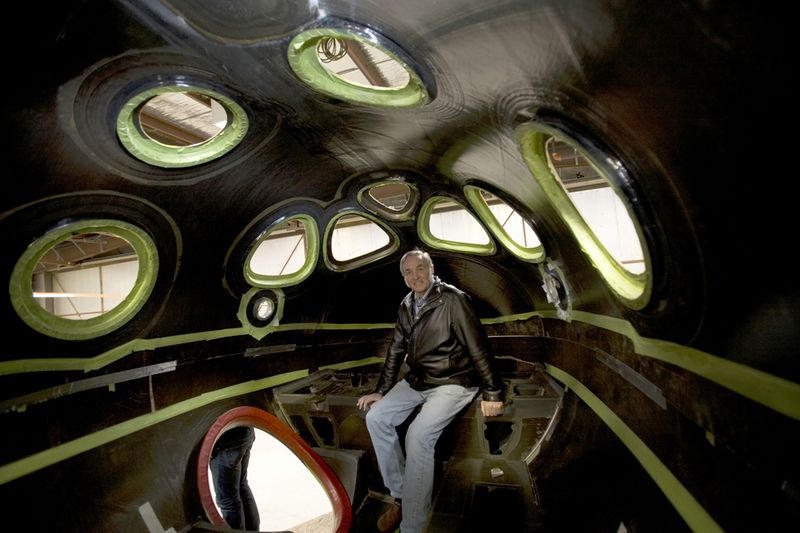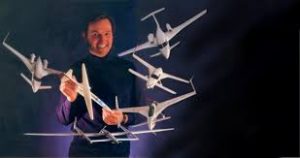The Man Who Changed The Complexion of Aviation, and Space, Using Simplicity as The Foundation For His Success – February 26, 2021

The Race to Be First – February 19, 2021
February 22, 2021
The Rest Of The Story – March 13, 2020
March 12, 2021RN3DB
February 26, 2021
Good Morning,
Recently we talked about the the race to be first in the jet age, as well as the race to develop a new SST for corporate operators. I was reminded how much I like, and respect, the work of Burt Rutan and his free-spirited, disciplined approach to be first with advanced aviation concepts. That having been said, I would like to share a blog from a year ago that details his accomplishments and captures his forward thinking/maverick personality.
Enjoy……
Burt Rutan
The Man Who Kept Simplicity as a Cornerstone of His Philosophy to Challenge The Establishment and Conquer Space.
Burt Rutan was born in 1943. He received his Bachelor of Science degree in Aeronautical Engineering at California Polytechnic University in 1965. His education includes the Space Technology Institute at Cal Tech and the Aerospace Research Pilot’s School at Edwards Air Force Base. Rutan holds, in addition, the honorary degree of Doctor of Science from California Polytechnic State University, San Luis Obispo, June 1987; Doctoral of Science, honoris causa, from Daniel Webster College, May 1987; Doctoral of Humanities, honoris causa, from Lewis University, May 1988 and Doctorate of Technology, honoris causa, from Delft University of Technology, January 1990.
Rutan worked for the U.S. Air Force from 1965 until 1972 as Flight Test Project Engineer at Edwards Air Force Base, California. His projects ranged from fighter spin tests to the XC-142 VSTOL transport.
In March 1972, Rutan became director of the Bede Test Center for Bede Aircraft in Newton, Kansas. In June of 1974, at Mojave, California, Rutan formed the Rutan Aircraft Factory (RAF) to develop light homebuilt aircraft. Through this company, the VariViggen, VariEze, NASA AD-1, Quickie, Defiant, Long-EZ, Grizzly, scaled NGT trainer, Solitaire, Catbird, and the world-flight Voyager aircraft were developed.
In April 1982, Rutan founded Scaled Composites (Scaled) to develop research aircraft. Since its founding, Scaled has been the world’s most productive aerospace prototype development company, developing new aircraft types at a rate of one each year. Past projects include the 85% scale Starship 1 for Beech Aircraft Corporation, the Predator agricultural aircraft for ATAC, the Scarab Model 324 reconnaissance drone for Teledyne Ryan Aeronautical, the Advanced Technology Tactical Transport (ATTT) for DARPA, the 1988 America’s Cup wing sail, the Triumph light executive jet for Beechcraft, the ARES close air support attack turbofan, the Pond Racer, the Pegasus Space launch vehicle flying surfaces, the Model 191 general aviation single for Toyota, a 40% scale B-2 bomber RCS model, General Motor’s 1992 show car (the GM Ultralite), the Bell Eagle Eye prototype tilt rotor RPV, the Earthwinds pressurized gondola, the McDonnell Douglas DC-X single stage rocket structure, the VisionAire Vantage business jet, the Raptor and Raptor D-2 high altitude RPVs for BMDO, a 40-meter wind generator for Zond,. three NASA X-38 crew return vehicles, the Williams, International V-Jet II, the high-altitude Proteus aircraft, the Adam Model 309 business aircraft, and the Rotary Rocket Roton atmospheric test vehicle. In 2008 Rutan was named Chief Technology Officer and Chairman Emeritus of Scaled Composites in a move that would allow him to focus on the company’s creative and entrepreneurial strengths.
Recent projects include the White Knight and Space Ship One, the world’s first privately funded spacecraft. He made international headlines on 21 June 2004, when with Mike Melvill at the controls, SS1 flew history’s-first private manned space flight. On 4 Oct 2004, SS1 won the $10M Ansari X-prize (two flights within 5 days flown by Melvill and Brian Binnie). The Virgin Atlantic GlobalFlyer designed and built at Scaled made its maiden flight in March 2004 and a record setting solo world flight in March 2005.
Two documentaries about Space Ship One, which was financed by Microsoft co-founder Paul Allen, aired on the Discovery Channel. Rutan was profiled in by 60 Minutes and featured on the covers of LIFE and TIME, which named Space Ship One “Invention of the Year” and Rutan “one of the world’s 100 most influential people in 2005.”
Named “Entrepreneur of the Year” by Inc. Magazine and described by Newsweek as “the man responsible for for more innovations in modern aviation than any living engineer,” Mr. Rutan is a bold entrepreneur and designer with the vision and passion for the advancement of technology. “Manned space flight is not only for governments to do,” says Rutan. “We proved it can be done by a small company operating with limited resources and a few dozen dedicated employees. The next 25 years will be a wild ride, one that history will note was done for everyone’s benefit.”
The Spaceship Company, jointly owned by Virgin and Scaled Composites, has been developing Space Ship Two for the past several years. The project, based on technology developed for Space Ship One, is a suborbital spaceplane designed to carry passengers and will be launched in 2009. Retiring from Scaled Composites as Chief Technical Officer in April 2011, he now assumes the title of founder and Chairman Emeritus.
Rutan is currently working with Microsoft co-founder Paul Allen on a new project, the Stratolaunch – part airplane, part spaceship – scheduled to fly by 2016.
A few of the awards which Mr. Rutan has received include:
- EAA Outstanding New Design, 1975, 1976 and 1978.
Presidential Citizen’s Medal presented by Ronald Reagan, December 29, 1986.
• Grand Medal of the Aero Club of France, January 29, 1987.
• National Medal of the Aero Club of France, January 29, 1987.
• Society of Experimental Test Pilots, 1987 J.J. Doolittle Award and 2004 J.J. Doolittle Award.
• Royal Aeronautical Society, British Gold Medal for Aeronautics, December 1987.
• Design News Engineer of the Year for 1988.
• Western Reserve Aviation Hall of Fame, Meritorious Service Award, 2 September 1988.
• The International Aerospace Hall of Fame Honoree, 24 September 1988
• Member, National Academy of Engineering, 1989.
• 1987 Robert J. Collier Trophy for ingenious design and development of the Voyager 15 May • National Aviation Hall of Fame Honoree, 21 July 1995.
• EAA Freedom of Flight Award, 3 August 1996
• EAA Homebuilders Hall of Fame, 23 October 1998
• Designer of the Year, Professional Pilot Magazine, 13 March 1999
• Clarence L. “Kelly” Johnson “Skunk Works” award by the Engineers Council, February 2000
• 2000 Lindbergh Award by the Lindbergh Foundation, May 20, 2000
• Aviation Week & Space Technology magazine’s “Laurel Legend” and Hall of Fame in April 2002, Current Achievement Award for first privately-funded manned space flight by Space Ship One in April 2005
• Aviation Week & Space Technology magazine’s “100 Stars of Aerospace” (ranked 29th), June 2003
• Scientific American magazine’s “Business Leader in Aerospace,” November 2003
• TIME Magazine’s “100 Most Influential People in the World,” April 18, 2005
What Does The Future Hold For Burt Rutan
Although Rutan is no longer as active at Scaled, he’s still involved in space exploration in other ventures. He recently joined the board of Stratolaunch Systems, an air-to-orbit launch system that is slated to have its first test flight in 2017.
The company – which also has financial backing from Allen – initially planned a system that would work with a SpaceX rocket. It aimed to bring 6,100 kilograms to low Earth orbit or 2,300 kg into geosynchronous orbit.
Scaled is involved in the project as well, as it is building a 490,000 pound (222,000 kg) “mothership” airplane able to fly up to about 1,500 miles (2,400 km) before releasing the rocket. But the system may undergo some changes amid a shakeup in late 2012. Space X announced it would pull out, and Orbital Sciences Corp. is now going to step in to try to keep the project on track.
“We have been engaging Orbital over the past few months and have them under a study contract through early next year with specific design deliverables,” Stratolaunch chief executive Gary Wentz wrote in a November 2012 e-mail to SPACE.com partner Space News.
The companies provided few details about the potential pact. “They are currently evaluating several alternative configurations that appear promising,” Wentz added. “We expect more information to be available in the February 2013 time frame.”
Rutan is also keeping busy with an idea for a hybrid flying car, which was revealed publicly amid a short test flight in 2011. Its advertised range is 760 miles (1223 km) in air, and 820 miles (1320 km) when skimming the ground.
The car, also a Scaled project, was unveiled to seek interest from potential customers. Company officials cautioned it was best not to get excited yet, but if it does come true, Rutan could be the architect of the long-held dream of flying cars. The car, also a Scaled project, was unveiled to seek interest from potential customers. Company officials cautioned it was best not to get excited yet, but if it does come true, Rutan could be the architect of the long-held dream of flying cars.
Have a good weekend, take time to enjoy life and family, and be true to yourself and your profession.
Robert Novell
February 26, 2021



